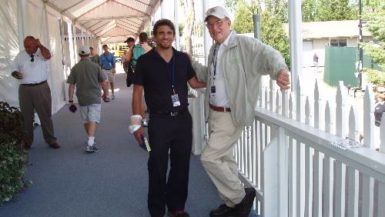THE LEGENDS at ROYAL NEW KENT
10100 Kentland Rd.
Providence Forge, VA
866.284.6534
804.966.7023
www.traditionalclubs.com
www.maverickgolftrail.com
Architect: Mike Strantz
Par – 72
Excitement Level – 10/12
Difficulty – 11/12
Cost – Peak $60-$79, Reduced $35-$59
Yearly Memberships – $$3,000 initiation
plus $150/mo single, $225/mo family – unlimited golf + amenities
Design – Six and 1/2 stars (out of seven)
Natural Setting – Five stars (out of seven)
Conditioning – Six stars normally, three stars with conditioning issues summer of ’05
Value – Five and 1/2 stars (seven if they get the conditioning issues resolved)
Overall: six and 1/2 stars
Tees Yards Rating Slope
Invicta 7374 76.5 152
Tournament 6965 74.9 144
Back 6560 73.1 141
Regular 6126 70.8 135
Forward 4971 72.0 130
Williamsburg Virginia’s rich history is echoed in a course which harkens back to the formative years of golf – Royal New Kent. Founded on the great traditions and designs of the game when it was first conceived, Royal New Kent’s windswept hills, towering fescue and nerve-testing blind shots are all reminiscent of the way the game originated across the pond.
Architect Mike Strantz forged a friendship with the staff and members of Royal County Down in Northern Ireland and frequently would play matches with them on both sides of the Atlantic. After seeing the rumbling, topsy-turvy landscape upon which the course now sits, he knew he had the perfect place to build a course to pay tribute to his friends and the courses of their homeland. However, as he is never one to settle for mere imitation, Strantz did not just mimic architectural elements of timeless classics like Royal County Down, Ballybunion and Sunningdale. Certainly he created a beautiful and accurate reproduction of a windswept inland links – right down to the mostly treeless landscape, open routes to most greens, and 134 deep bunkers. But Strantz also infused his own inimitable style to the template by adding yawning chasms, enormous multi-tired greens, and over-sized, over-the-top dunes and bunkers to produce dramatic vistas and strategic shot values. Everything at RNK is huge – the bunkers, the greens, the forced carries – everything. The end result is a fierce and intimidating behemoth of a golf course which exposes any and all weaknesses in a player’s game and ruthlessly metes out punishment. Despite its difficulty, since its opening in 1996 to industry-wide acclaim, players have made the pilgrimage for a true and unique test of their talent and psyche. When you think you are good, come to Royal New Kent.
Amazingly, Strantz actually moved very little earth to build RNK. He merely cut down a few low positions, added height to some high spots and created the illusion of moving many cubic yards of dirt. Such an illusion is a microcosm of the course design itself. Wider than it looks (and therefore easier than it looks – to a degree), strategic options are plentiful. Further, width allows less skilled players to enjoy the course more and play at a faster pace. At the same time the course is as beautiful as it is rugged. Each and every hole is memorable in its design – so much so that it is impossible for players to agree on any one “signature hole.” But players should not get distracted by the views – each hole is also another opportunity for the course to wreck a player’s scorecard and shatter a golfer’s ego. Royal New Kent is designed for experienced golfers – it is a double black diamond ski run, two blitzing all-pro linebackers, and a Randy Johnson fastball all rolled into one.
At the start of the round, pick the correct set of tees. The regulation tees (whites – Rating 70.8, Slope 135) appear short on the card (6,126 yards), but the forced carries, wind, enormous mounds (to play in, around and sometimes over), and constant uphill approach shots make the course play much longer. The advanced tees (black – Rating 73.1, Slope 141) play a seemingly manageable 6,560 yards, but the forced carries and angles are much more pronounced. The tournament tees (gold – Rating 74.9, Slope 144) are more than enough challenge for any expert golfer, stretching to 6,965 yards. Finally, for professionals, posers, egotists, and fools, the “Invicta” (Latin for “Unconquerable”) tees (tips – Rating 76.5, Slope 152) stretch this already tortuous layout to an ungodly 7,374 yards. Both the Course rating and Slope are higher than the legendary Bethpage Black Course, site of the 2002 U.S. Open. However, players can only play the Invicta tees if they leave their driver’s license or credit card at the pro shop. These are returned in exchange for the players’ scorecard upon completion of their round. Scorecards are displayed in the clubhouse grill room for the amusement of all. The course can be tough on ladies and beginners as the forward tees (green) have several intimidating forced carries off the tee, but since they measure less than 5,000 yards, the course should be manageable.
ON THE COURSE
Most golf course architects like to get the player off to an easy start with a relatively mild opening hole or two – but not Mike Strantz. Indeed, at RNK the worst three may be the first three. Standing on the first tee, one can barely see any of the first fairway as it winds and twists like a will-o-the-wisp some 90 feet below through towering dunes. Even worse, its false front green slopes so severely back toward the fairway that many poorly-played chips or downhill putts will roll nearly 60 yards back down the fairway from which the player came. Many unwary victims begin their round with this ignominious walk of shame.
For those still mumbling about their poor start, the par five, 512 yard second hole offers no solace. The course commands the golfer’s attention with one of the most intimidating sights on any golf course, anywhere. After driving uphill out of a stand of trees, the hole turns right and reveals a yawning chasm of hip high rough and broken scrub which lies at the bottom of a fifty foot deep crevasse. The minimum carry on the second shot is 225 yards to a sliver thin green which is also guarded by a bunker on the left and trees behind. Conservative players may lay up well to the left to face a shorter but just as perilous third shot approach.
More careful analysis of the hole reveals that it is not just “hard for hard’s sake,” but demands smart play and accurate execution. The hole is actually very similar to another superb hole – number 13 at The Dunes Club in Myrtle Beach. Both holes are dog-leg right par 5s and both feature a dramatic hazard that must be carried on either the second or third shot. But, the shot values demanded of the player are similar too. Both tees shots must be placed on the right side of the fairway to offer any hope of getting home in two. The left side of the fairway is the optimum side to aim for if a player will lay up. Those who find themselves on the right and decide to play safe, have a more difficult angle of play. One note: the green at RNK is far shallower than its counterpart at The Dunes.
The par three third requires a long iron over two bunkers which are cut obliquely in front of the edge of the green and continue around the left side. Any shot short or left leaves the player with blind chip shot from a sand trap situated forty feet below the hole. Left or short are not options here. All in all they are three holes of sheer terror. Nevertheless, the course does not get significantly easier, it just settles into a constant dull roar of demanding shots.
Take, for example, the monstrous 576 yard par five fifth. Seven bunkers encircle the landing area, including three massive cross bunkers which segment the landing area from the rest of the hole. Second shots must be played over the bunker complex to reach the second part of the fairway. The dunes framing the hole are so massive players feel like fleas walking on the back of a beast.
Similar in design to number 3, the 186 yard, par three seventh features a rocky brook that cuts diagonally from the front of green to the back left corner. Any shot that lands short will be played uphill from heavy rough situated thirty to forty feet below the putting surface.
After a short par four featuring a semi-blind approach to a green beautifully nestled among two mounds and a tight par four ninth, the back nine opens with a terrific risk reward par five. The tee shot plays directly over a set of bunkers to the widest fairway on the course. The approach must carry a waste area and bunker to reach the two tiered green.
If there is any relief to be offered at Royal New Kent, the greens are over sized, so careful players can try to play safely to the middle and minimize the severe penalty which imprudent or misplayed shots will incur. However, the enormous greens frequently feature pronounced tiers making lag putts from the wrong portion of the putting surface challenging. The 86 yard long green at number twelve is the most difficult as two large greenside mounds pinch the middle of the green essentially making two separate 40 yard greens. Put the ball in a spot on the green where one of the mounds blocks the direct path to the hole and face the frustrating task of putting sideways to a position which offers a direct line to the hole.
By the time one reaches the fifteenth tee, players are frequently drained both physically and mentally. Nevertheless, the finish at Royal New Kent is unyielding. Fifteen, a par three, plays over 200 yards and features a severe false front green. Shots short or right will lead to another 40 yard chip shot. The 459 yard sixteenth frequently requires three shots to reach the green as a ravine cuts in front of the putting surface. The last of the par fives, seventeen, entices the player to go for the green in two, but a stream runs along the front and right edges ready to catch any shot that does not land on the putting surface.
After seemingly emptying the bag of tricks, Strantz mischievously requires the golfer to negotiate two forced carries over water on the last hole. The tee shot plays blindly over 100 to 120 yards of water to a small landing area. The short or mid-iron approach is to an essentially island green completely encircled by 110 yards of water in the front and a creek circling around the back. A narrow path runs along the very left of the fairway to a small entry to the green, but even that route is perilously close to a watery doom. It’s strictly hero or zero on this approach. Interestingly, design constraints led to its creation. The course needed an irrigation lake so the course could be watered. The only location was the 18th green complex. Even that was not large, enough, so they pulled the 100 yard section from in front of the green. It is not an authentic links design, but who cares – it is unforgettable. The drama and tension caused by these all or nothing shot values makes the eighteenth a world class finishing hole worthy of mention beside any of the great finishing holes in America.
CHIP SHOTS AND TAP-INS
Royal New Kent is a devilish, but ingenious test of a golfer’s skill and psyche. Not only are tee shots intimidating, but the approaches have wonderfully high shot values. Most of the real difficulty at RNK stems from the penal nature of misplayed second shots. Bunkers are enormous and deep and swales are quixotic and severe. There are few courses with more tortuous up and down challenges from greenside than RNK. Despite its difficulty, RNK’s design is so unique and creative, all players will have fun, no matter what they shoot. Royal New Kent’s central location makes it easily accessible from the Carolinas, Washington, DC, or other Mid-Atlantic and southern locales. Richmond is only located only twenty miles east, off Interstate 64 and Williamsburg feels like a mere five iron away. Royal New Kent’s beauty, conditioning, difficulty and unique design make it one of the nation’s finest facilities and it is a steal at the paltry fee of around $60.





[…] Royal New Kent, The Dixie Cup and Best New Private Course 2006 […]
[…] I’ll review Lederach again later this week, but that also should be in the menu before heading into DelMarVa and points south. Next stop after DC? Williamsburg for Royal New Kent and Stonehouse! […]